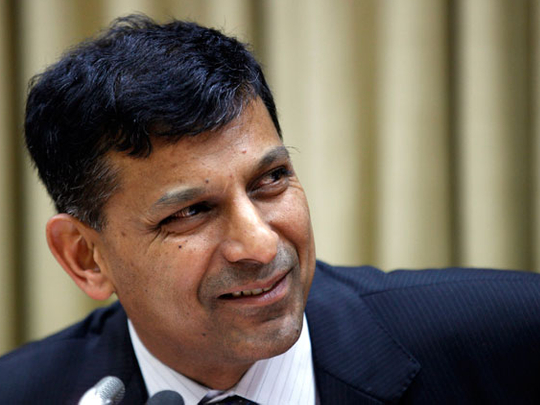
Indian markets pulled off a surprising rebound this week after a whiff of fresh air from the country’s central bank calmed jittery nerves and spurred bargain hunting, but there are big question marks about sustaining the recovery in the face of formidable challenges for an economy under enormous stress.
Raghuram Rajan, a former chief economist of the International Monetary Fund who took over as the governor of the Reserve Bank of India, broke with the staid tradition at the central bank by unveiling on debut a gung-ho package to deal with the rupee’s unprecedented slump. It was a spectacular performance, televised live, which brought gushing accolades from the media and revived investor confidence.
The rupee, which had defied a spate of measures to halt its free fall since May, abruptly bounced back from record lows and the stock market roared again. The feel-good sentiment underscored a vital point: Much of India’s problems could be traced to the quality of leadership.
Must-read
Rajan, whose impeccable credentials come from presenting a paper in the US in 2005 about the coming global economic crisis, knows the issues in India like the back of his hand, having been the economic advisor to the finance ministry in New Delhi for some time now. Still, no one expected the 50-year-old to hit the ground running.
“The statement is impressive and a must-read,” noted Deutsche Bank about Rajan’s inaugural address, which laid out a plan to boost dollar inflows and simultaneously relaxed some norms on outbound investments. The sheer breadth and depth of the policy blueprint stood in sharp contrast to his 22 predecessors at the RBI, especially the outgoing D. Subbarao who took charge five years ago with a one-line statement on inflation.
Fresh air
Little surprise the German bank called Rajan a “breath of fresh air”. The rupee climbed nearly three per cent over two days to its highest close in almost two weeks at 65.25 against the dollar, recovering sharply from an all-time low of 68.85. What did Rajan do to engineer the change in sentiment?
For starters he pinned on tapping the Indian diaspora, by using a least cost option to attract inflows. Non-resident Indians are allowed to hold dollar deposits with banks at comparatively higher interest rates. The RBI said banks can borrow an additional 50 per cent of their net worth or convert dollar deposits into rupees for which the central bank would offer a swap rate at 3.5 per cent, sharply off hedging rates of 6-8 per cent in the market.
In a nutshell, the RBI cushions the currency risk while enabling the banks to reap higher interest earnings.
“This, along with a few other measures, could attract $10 billion of forex inflows in next three months, on our estimates, and could be a material near-term positive for the INR,” Barclays said in a report.
“In our view, a meaningful improvement in INR sentiment would raise the likelihood of a rollback in September-October of some of the RBI’s recent liquidity-tightening measures. That said, we acknowledge the risks stemming from greater near-term uncertainties in global markets,” it said.
As the rupee rebounded investors also strode back into the stock market. The widely tracked top-30 Sensex rose 3.5 per cent in the week to Friday to 19,270.06, while the broader 50-share Nifty rallied 3.8 per cent to 5,680.40, as some large foreign funds scooped up shares that were looking far cheaper with the rupee’s more than 20 per cent fall since May.
Strong headwinds
For all of Rajan’s famed wizardly the ammunitions at his disposal are acutely limited to tackle the structural and systemic problems hobbling the economy. More aptly in some ways his hands are tied, particularly over the near term as inflation pressures mount on the back of the weaker currency.
Prices of fuel, which India imports in large quantities, are rising at a fast clip and leave no room for the RBI to loosen monetary policy. With growth rates plunging and sluggish consumer spending forcing companies to curtail output and cut staff, the outlook is very much weighed down.
Some economists are demanding the central bank to raise interest rates to support the rupee and douse inflation pressures, already undertaken by peers such as Indonesia and Brazil. However, industry captains have been crying hoarse against any such move while mandarins in New Delhi with an eye on coming national elections want the RBI to ease rates.
There is more evidence that economic growth in the September quarter would be further down from the four-year low of 4.4 per cent in April-June.
Factory activity is contracting. The purchasing managers’ index compiled by HSBC-Markit shrank for the second straight month in August. Services activity contracted in August at its fastest pace since the worst of the global financial crisis.
GDP growth
“The numbers we have seen so far for July and August for both the manufacturing and service sectors point to a further slowdown in GDP growth during the third quarter,” said Leif Eskesen, chief economist for India at HSBC.
Morgan Stanley cut its top-30 Sensex earnings growth estimates to 4.1 per cent for 2013-14 from 10.5 per cent and to 12.7 per cent from 19 per cent for the following year.
“Our new macro forecasts imply that the earnings trajectory will weaken in the near term and the ensuing recovery is likely to slow,” the US bank analysts Ridham Desai, Sheela Rathi and Utkarsh Khandelwal wrote in a report.
“We issue a new 12-month forward Sensex target of 18,200. Given the tail risks, we underscore our bear case — a 14 per cent fall in the Sensex with a 35 per cent probability.”
The writer is a journalist based in India












